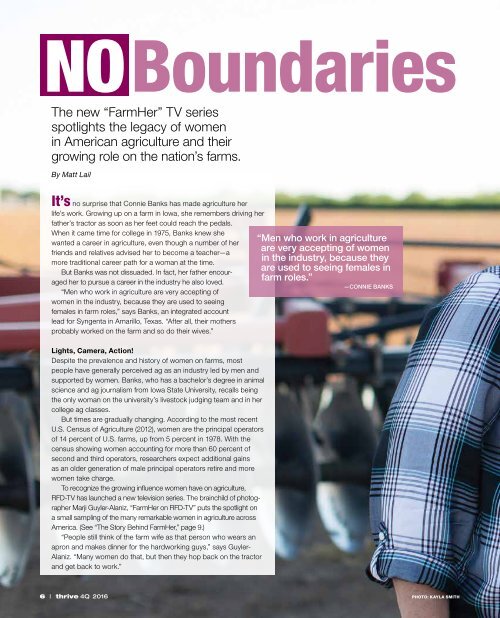thrive
current-issue
current-issue
You also want an ePaper? Increase the reach of your titles
YUMPU automatically turns print PDFs into web optimized ePapers that Google loves.
NO Boundaries<br />
The new “FarmHer” TV series<br />
spotlights the legacy of women<br />
in American agriculture and their<br />
growing role on the nation’s farms.<br />
By Matt Lail<br />
It’s no surprise that Connie Banks has made agriculture her<br />
life’s work. Growing up on a farm in Iowa, she remembers driving her<br />
father’s tractor as soon as her feet could reach the pedals.<br />
When it came time for college in 1975, Banks knew she<br />
wanted a career in agriculture, even though a number of her<br />
friends and relatives advised her to become a teacher—a<br />
more traditional career path for a woman at the time.<br />
But Banks was not dissuaded. In fact, her father encouraged<br />
her to pursue a career in the industry he also loved.<br />
“Men who work in agriculture are very accepting of<br />
women in the industry, because they are used to seeing<br />
females in farm roles,” says Banks, an integrated account<br />
lead for Syngenta in Amarillo, Texas. “After all, their mothers<br />
probably worked on the farm and so do their wives.”<br />
Lights, Camera, Action!<br />
Despite the prevalence and history of women on farms, most<br />
people have generally perceived ag as an industry led by men and<br />
supported by women. Banks, who has a bachelor’s degree in animal<br />
science and ag journalism from Iowa State University, recalls being<br />
the only woman on the university’s livestock judging team and in her<br />
college ag classes.<br />
But times are gradually changing. According to the most recent<br />
U.S. Census of Agriculture (2012), women are the principal operators<br />
of 14 percent of U.S. farms, up from 5 percent in 1978. With the<br />
census showing women accounting for more than 60 percent of<br />
second and third operators, researchers expect additional gains<br />
as an older generation of male principal operators retire and more<br />
women take charge.<br />
To recognize the growing influence women have on agriculture,<br />
RFD-TV has launched a new television series. The brainchild of photographer<br />
Marji Guyler-Alaniz, “FarmHer on RFD-TV” puts the spotlight on<br />
a small sampling of the many remarkable women in agriculture across<br />
America. (See “The Story Behind FarmHer,” page 9.)<br />
“People still think of the farm wife as that person who wears an<br />
apron and makes dinner for the hardworking guys,” says Guyler-<br />
Alaniz. “Many women do that, but then they hop back on the tractor<br />
and get back to work.”<br />
“Men who work in agriculture<br />
are very accepting of women<br />
in the industry, because they<br />
are used to seeing females in<br />
farm roles.”<br />
—CONNIE BANKS<br />
6 | <strong>thrive</strong> 4Q 2016 PHOTO: KAYLA SMITH


